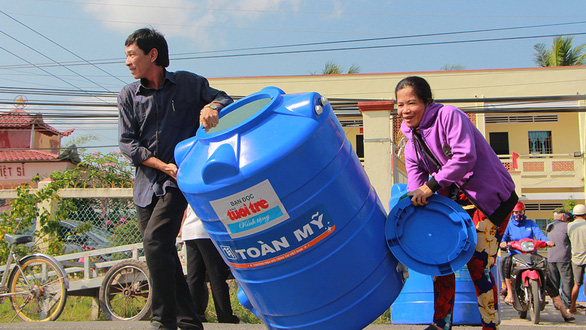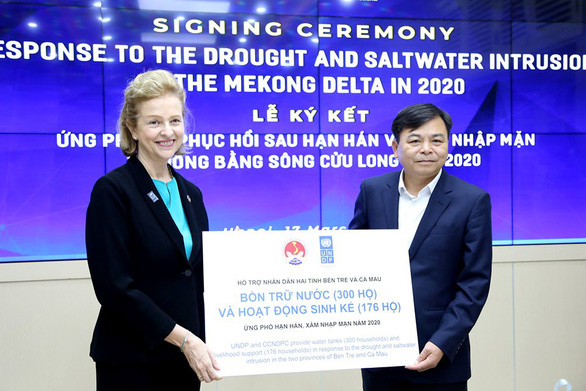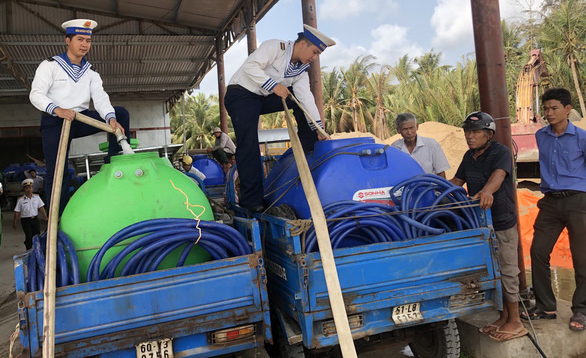Forces from different sectors have taken joint action to help people in the Mekong Delta region of Vietnam cope with historic drought and saltwater intrusion described as one of the century’s worst.
The Vietnam People’s Navy is the latest force to have shown support for salinity-hit Mekong Delta provinces.
On Wednesday, two ships of the Second Region Command and the Vietnam Naval Academy transported 1,200 cubic meters of fresh water in total to Mo Cay Nam District in Ben Tre Province and Go Cong Dong District in Tien Giang Province.
The previous day, the United Nations Development Program (UNDP) presented US$185,000 funded by the Global Emergency Fund to the Ministry of Agriculture and Rural Development to back the Mekong Delta’s response efforts.
As part of its assistance, the UNDP also provided 300 water tanks for affected households in Ben Tre Province and offered livelihood support for 176 other families in Ca Mau Province.
Several Vietnamese artists, singers, entertainers, and celebrities have donated billions of Vietnamese dong to install water purifiers across Mekong Delta localities. ($1 = VND23,246)
Historic drought and salinity intrusion
Vietnam’s prolonged drought, coupled with an extensive build-up of salinity, has driven five provinces in the Mekong Delta’s ‘rice basket’ -- Kien Giang, Ben Tre, Tien Giang, Ca Mau, and Long An -- to declare a state of emergency.
The Mekong Delta, which produces more than half of the country’s rice, has so far seen a total of 33,000 hectares of rice paddies damaged and nearly 70,000 households suffering from the lack of water, according to the Vietnam Government Portal.
|
|
| UNDP Resident Representative in Vietnam Caitlin Wiesen (L) hands over Global Emergency Fund's aid to Deputy Minister of Agriculture and Rural Development Nguyen Hoang Hiep at a signing ceremony in Hanoi, Vietnam, March 17, 2020. Photo: Minh Phuc / Tuoi Tre |
Salinity of four grams per liter will continue to spread in the Mekong Delta, penetrating as deep as 110 kilometers from some major estuaries this month, according to a report by the Southern Institute of Water Resources Research in Ho Chi Minh City.
That is three to five kilometers more than in the same period in 2016, when the region was hit by what was widely described as the worst drought it had seen in a century.
The persistent drought in the Mekong Delta in 2016 caused losses worth VND8.9 trillion ($380 million) with 250,000 hectares of rice, 130,000 hectares of other crops, and 30,000 hectares of fruit farms destroyed, according to the local news website VnExpress.
The government estimates drought and salinity will affect 362,000 hectares of rice and 136,000 hectares of fruit trees in the Mekong Delta this year, while more than 120,000 households will suffer from water shortage.
As of March, salinity had hit about half the districts in ten out of the 12 provinces and one city in the region.
Some 90,000 people have had insufficient access to water for drinking and domestic use, according to the Vietnam News Agency.
In many provinces in the area, people have had to pay up to VND300,000 ($12.8) for a cubic meter of fresh water.
Experts say saline intrusion and drought will be even harsher in the next two months as it is just halfway into the dry season, which starts in late November and lasts until May, in the Mekong Delta.
Solutions
Kien Giang Province built water-inflated temporary dams to divert the water flow on Ong Hien Canal to prevent the saline intrusion from hitting the Long Xuyen Quadrangle area, said Kien Giang’s Agriculture and Rural Development director Nguyen Van Tam.
The Long Xuyen Quadrangle is a 489,000-hectare area in the Mekong Delta delimited by the Vietnam-Cambodia border, the Gulf of Thailand, the Cai San Canal, and the Hau (Back) River.
|
|
| Naval soldiers pump fresh water from ships into water tanks for local use in Mo Cay Nam District, Ben Tre Province, March 18, 2020. Photo: Vo Minh Thang / Tuoi Tre |
Kien Giang has also invested in expanding its water pipelines network and raising the capacity of water supply plants.
In the meantime, tanker trucks are used to transport fresh water to local households.
Ben Tre also followed suit in constructing a temporary dam to prevent saline water from penetrating the Ba Lai River in Chau Thanh District.
In addition, the province has dredged the local Ma River to limit saline intrusion.
Ben Tre has also installed reverse osmosis water purifiers at twelve out of 35 water plants in the province.
Tien Giang has begun constructing a steel dam on Nguyen Tan Thanh Canal to conserve fresh water for the province’s eastern part and the western part of its capital city of My Tho, where more than 800,000 households are located.
The dam is expected to also contribute to saving fresh water for Tien Giang’s Tan Phuoc District and the neighboring province of Long An.
Tien Giang has installed 50 public faucets for 2,200 households to use.
Long An Province provided funding to buy 160 water tanks for households in need in Can Giuoc District.
Bac Lieu is fronting capital to expand 36 kilometers of pipe network and drill four more underground water wells to supply water to affected households.
Meanwhile, large-scale agricultural production areas such as Ca Mau Peninsula, Long Xuyen Quadrangle, South Mang Thit, and Phung Hiep have closed hundreds of sluices and dams to prevent saline intrusion.
In the long term, Ky Quang Vinh, former staff of the Office for Climate Change in Can Tho City, advised localities build freshwater reservoirs.
“Farmers should be encouraged to have their own reservoirs,” said Vinh.
“The government can provide [the farmers with] tarpaulins, technical assistance, and guidance on irrigation methods,” he added.
Like us on Facebook or follow us on Twitter to get the latest news about Vietnam!
























































